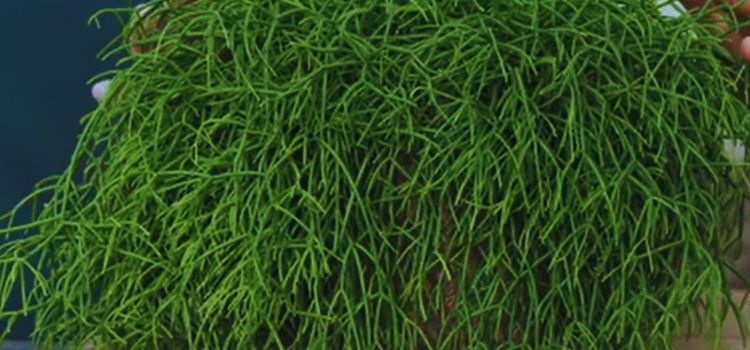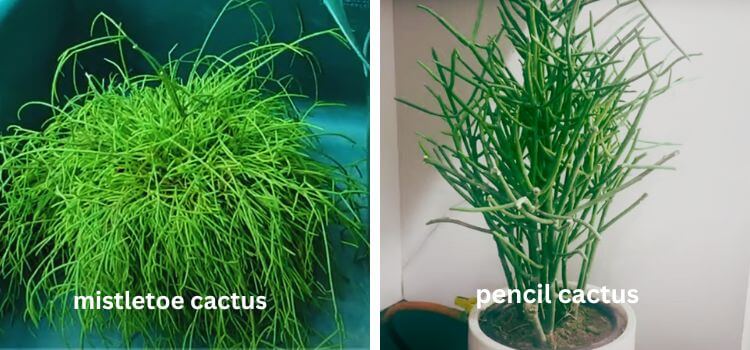As an Amazon Associate, I earn from qualifying purchases.
If you’re into plants like I am, you’ve probably wondered about the differences between the Mistletoe Cactus vs Pencil Cactus. I know I did when I first spotted them in a nursery. Both have their charm, but it wasn’t until I brought them home that I realized just how distinct they are.
The Mistletoe Cactus has this quirky, cascading look, while the Pencil Cactus has a more upright, bold appearance. Both are easy to care for, but they do have their differences in how they grow and need to be maintained.
I’ve learned a lot through trial and error, and I can tell you that deciding between them comes down to your space and style. In this post, I’ll share my experience with both plants and help you figure out which one might be the best fit for you!
Physical Characteristics
Exploring the intriguing world of houseplants brings us to two unique species: the Mistletoe Cactus and the Pencil Cactus. Both plants add a touch of nature’s wonder to indoor spaces. Yet, they flaunt distinct physical traits. Let’s dive into the captivating features that set these succulents apart.
Mistletoe Cactus Features
The Mistletoe Cactus (Rhipsalis baccifera) stands out with its jungle origins. Unlike typical cacti, it thrives in tropical climates. Its features include:
- Leafless stems: Green, slender, and often branching.
- Trailing growth: Perfect for hanging baskets.
- Small flowers and berries: White to pink blossoms turn into mistletoe-like berries.
Pencil Cactus Features
The Pencil Cactus (Euphorbia tirucalli), also known as the Milkbush, boasts a striking silhouette. This plant’s characteristics are:
- Thin, cylindrical branches: Resemble green pencils.
- Height: Can grow tall, up to 30 feet in the wild.
- Toxic sap: Produces a milky latex that can be an irritant.
| Mistletoe Cactus | Pencil Cactus |
|---|---|
| Jungle cactus with trailing stems | Upright cactus with pencil-like branches |
| Adapts to low-light conditions | Prefers bright, indirect sunlight |
| Berries resemble mistletoe | Milky latex can be harmful |

Growing Conditions
The right growing conditions can make or break your indoor garden, especially when dealing with unique plants like the Mistletoe Cactus and Pencil Cactus. Each plant thrives under specific conditions, which are essential for successful cultivation.
Ideal Environment For Mistletoe Cactus
The Mistletoe Cactus, known scientifically as Rhipsalis, prefers a humid environment with indirect light. This makes it perfect for indoor areas away from direct sunlight. Here are key points for its care:
- Temperature: Keep it between 60-75°F (15-24°C).
- Humidity: High humidity levels, around 50-70%.
- Watering: Water when the top inch of soil feels dry.
- Soil: Use a well-draining potting mix.
Ideal Environment For Pencil Cactus
The Pencil Cactus, or Euphorbia Tirucalli, is a hardy plant that loves lots of light. Here’s how to provide the best environment for it:
- Light: Needs bright, direct sunlight.
- Temperature: Prefers warmer conditions, above 70°F (21°C).
- Watering: Allow soil to dry completely between watering.
- Soil: A cactus mix or sandy soil is ideal.
Both plants require specific care, but with the right conditions, they can both thrive beautifully in your home.
Care And Maintenance
Keeping your cacti healthy involves simple yet specific steps. Whether you own a mistletoe cactus or a pencil cactus, understanding their unique needs is crucial. Below, find tailored tips for each plant to ensure they thrive in your care.
Tips For Caring For Mistletoe Cactus
The mistletoe cactus, a forest dweller, loves indirect light and humidity. Follow these tips:
- Water generously during growing seasons (spring and summer).
- Reduce watering in fall and winter to prevent root rot.
- Use a peat-based potting mix with good drainage.
- Maintain humidity by misting the plant or using a humidity tray.
- Keep in a spot with bright, indirect sunlight.
Tips For Caring For Pencil Cactus
The pencil cactus, a sun-loving plant, requires different care:
- Place in a location with direct sunlight.
- Water sparingly, only when the soil is completely dry.
- Use a sandy potting mix to improve drainage.
- Avoid overwatering to protect against root diseases.
- Please handle it with care; its sap is toxic and can irritate the skin.
Care Comparison:
| Cactus Type | Light Needs | Watering Needs | Soil Type |
|---|---|---|---|
| Mistletoe Cactus | Indirect light | Moderate | Peat-based, well-draining |
| Pencil Cactus | Direct sunlight | Low | Sandy, well-draining |

Propagation
Let’s dive into the exciting world of plant propagation. Propagation is a way to create new plants from the ones you already love. It’s like making a clone of your favorite plant. Mistletoe cactus and pencil cactus both offer unique propagation methods. This guide will make it easy for you to grow more of these beautiful plants.
Methods Of Propagating Mistletoe Cactus
Propagating mistletoe cactus can be fun and simple. Seed sowing and stem cuttings are the go-to methods. Here’s how to do it:
- Seed Propagation: Plant seeds in well-draining soil, keeping them warm and moist. Patience is key, as seeds take time to sprout.
- Stem Cuttings: Snip a healthy stem. Let it dry for a day. Plant it in moist soil. Roots will grow in a few weeks.
Methods Of Propagating Pencil Cactus
Pencil cactus propagation is equally thrilling. Stem cuttings are the usual method. Follow these steps to ensure success:
- Cut Wisely: Choose a healthy stem. Use gloves to protect from sap. Cut a 6-inch piece.
- Prep the Cutting: Let the cut end dry. This avoids rot and allows a callus to form.
- Plant the Cutting: Once dry, place the cutting in the soil. Water sparingly. Roots will appear in a few weeks.
Common Pests And Diseases
Even the most resilient plants, like the Mistletoe Cactus and Pencil Cactus, face threats. Pests and diseases can harm these succulents. Let’s explore the common issues they encounter and ways to keep your green friends healthy.
Pests Affecting Mistletoe Cactus
Spider mites and scale insects can trouble Mistletoe Cactus. These tiny bugs suck sap and weaken the plant. Signs include yellow leaves and a sticky residue on the cactus.
- Use a mild soap solution to clean the leaves.
- Apply neem oil as a natural pest deterrent.
Pests Affecting Pencil Cactus
The Pencil Cactus can fall prey to mealybugs and aphids. These pests can cause stunted growth and leaf loss.
- Remove pests manually with a soft cloth.
- Spray insecticidal soap to eliminate infestations.
Diseases In Mistletoe Cactus
Root rot is a common issue when the soil doesn’t drain well. Overwatering is often the cause.
- Ensure proper drainage in the pot.
- Let the soil dry between waterings.
Diseases In Pencil Cactus
Similar to the Mistletoe Cactus, the Pencil Cactus can suffer from root rot and fungal infections, which can arise in damp conditions.
- Reduce watering frequency to prevent overwatering.
- Use a well-draining soil mix.
Decorative Uses
When it comes to adding a touch of green to your living space, Mistletoe Cactus and Pencil Cactus are standout choices. Both plants offer unique shapes and textures that can enhance any room’s aesthetic. Perfect for modern, minimalist, or bohemian styles, these cacti can become stunning focal points. Let’s dive into the best ways to showcase these succulent beauties in your home.
How To Decorate With Mistletoe Cactus
The Mistletoe Cactus, with its cascading tendrils, is ideal for hanging planters. Here’s how to make it a standout decor element:
- Choose a Bright Spot: Hang it near a window where it gets indirect light.
- Use Macrame Planters: Add a boho touch with a stylish macrame hanger.
- Create Levels: Place it at different heights with other plants for a layered look.
- Go Solo: Let it shine on its own as a living centerpiece.
How To Decorate With Pencil Cactus
The Pencil Cactus is known for its striking, upright form. Follow these tips to decorate with this eye-catching plant:
- Opt for Minimalist Pots: Use simple pots to let the plant’s form stand out.
- Place for Impact: Position it in a corner or beside furniture for a dramatic effect.
- Play with Color: Its vibrant green pairs well with bold wall colours.
- Add Height: Elevate it on a stand to enhance vertical interest.
Frequently Asked Questions
No, a pencil cactus (Euphorbia tirucalli) and a mistletoe cactus (Rhipsalis baccifera) are not the same. They are different species with distinct appearances and growing habits.
The Firestick plant, scientifically known as Euphorbia tirucalli, closely resembles the pencil cactus. Both belong to the Euphorbia family and share a similar appearance with their thin, stick-like branches.
The common name of the pencil cactus is Indian Tree Spurge.
Rhipsalis, a jungle cactus with similar trailing stems, is akin to mistletoe cactus. Other close relatives include the chain cactus (Cereus) and the Christmas cactus (Schlumbergera).
Conclusion
Deciding between mistletoe cactus and pencil cactus brings unique charm to any space. Both plants offer distinct textures and growth habits suited to varied tastes and environments. Embrace the lush, trailing beauty of mistletoe cactus or the striking, vertical lines of pencil cactus.
Whichever you choose, your indoor garden will surely thrive.

